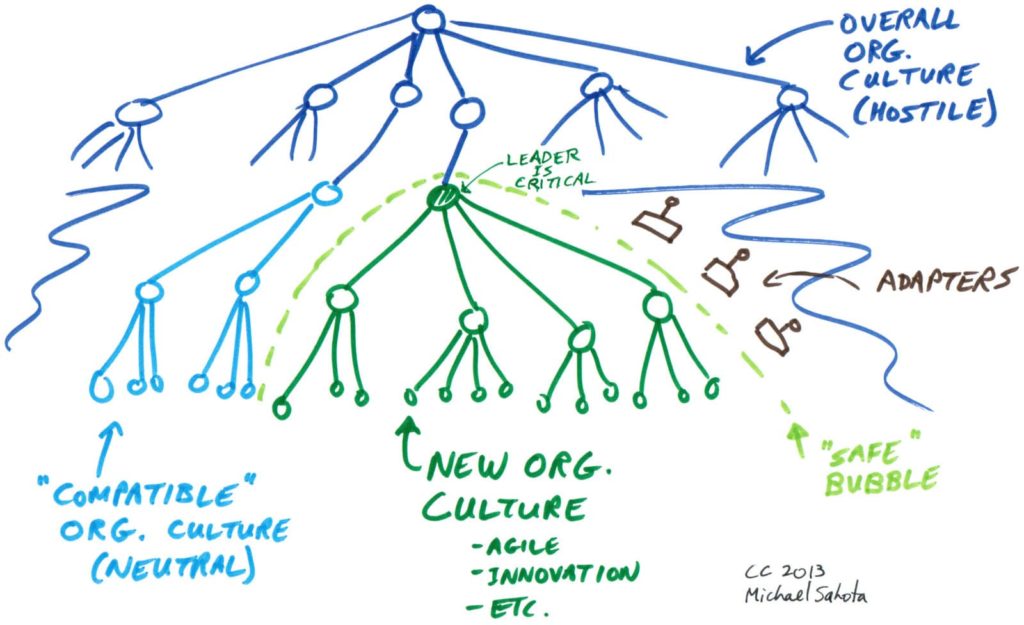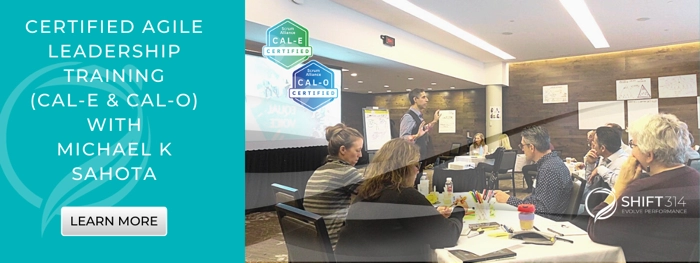This post is about how one can create a bubble of a new culture inside of an existing organization. For example, this may be used by a group interested in developing an innovation and learning culture inside a typical bureaucratic organization. This post is a continuation of my earlier post on how to Build Culture Adapters to Avoid Agile Failure.
I realized that I have drawn the diagram below dozens of times with clients, prospects and colleagues over the last year and realized other people may be interested in it.
The drawing below shows the hierarchy of a typical organization with a dominant culture (in blue) and a new culture bubble formed (in green).

Given the nature of a power hierarchy in traditional organizations, a leader/manager can induce a culture shift in the organization that reports into her. See Transformation? Leaders Go First! for an explanation of how leaders can support a transformation process.
It is of course, critically important to build adapters around your bubble so that it can safely interface with the rest of the organization and avoid trigger the attack of organizational anti-bodies.
A final comment is regarding the cooperation of partner groups (in light blue) that are tightly bound to the same customer value stream. The close cooperation required for success necessitates a higher level of alignment. This means that the partner group must either help lead the culture change (and go green) or at a minimum be neutral (as show in light blue).
In a software context, a very tight relationship exists between the product and development groups since they need to work together to create customer value. A common pattern is for the green bubble to be the development and the blue bubble to be product.
When and How to Use This Diagram
I typically draw this picture and provide this explanation when socializing alternative approaches to Agile. In virtually all cases, the change agent leading the Agile initiative is not the CEO and does not have a span of control or influence over the whole organization. It is usually the case that typical “modern” management practices are in place that are regressive and hostile to fostering an Agile culture. So most leaders have the option of sticking to the adoption of practices that are consistent with the existing organizational culture or undertake a transformation of their group to realize a new culture that is supportive of Agile.
It is of particular importance, that as an external change artist, we are fully respectful of our client’s wishes and intents. It’s their organization after all. For some coaches this means letting go of the dream of helping the organization move forward on the road towards an Agile mindset – or “real” Agile.

Related Work?
Some time ago I shared George Schlitz and Giora Morein’s Agile Enablement Battlefield model to help understand how a transition is progressing. I am no longer a big fan of the metaphor of war, however, the notions of “fog of war” can be helpful. As well, I have seen increasing danger and harm caused by wolves in sheep’s clothing. These are the folks who say they are on board and go along with changes, but resist in passive ways. Of course, this is a natural and understandable response to coercion. If we really want to change our organizations then coercion is a tool that we need to leave behind.
Acknowledgments
The basic ideas of managing gaps in culture comes from William Schneider’s book How to Make your Culture Work. Many thanks also to all the various workshop participants who validated that these patterns apply.


